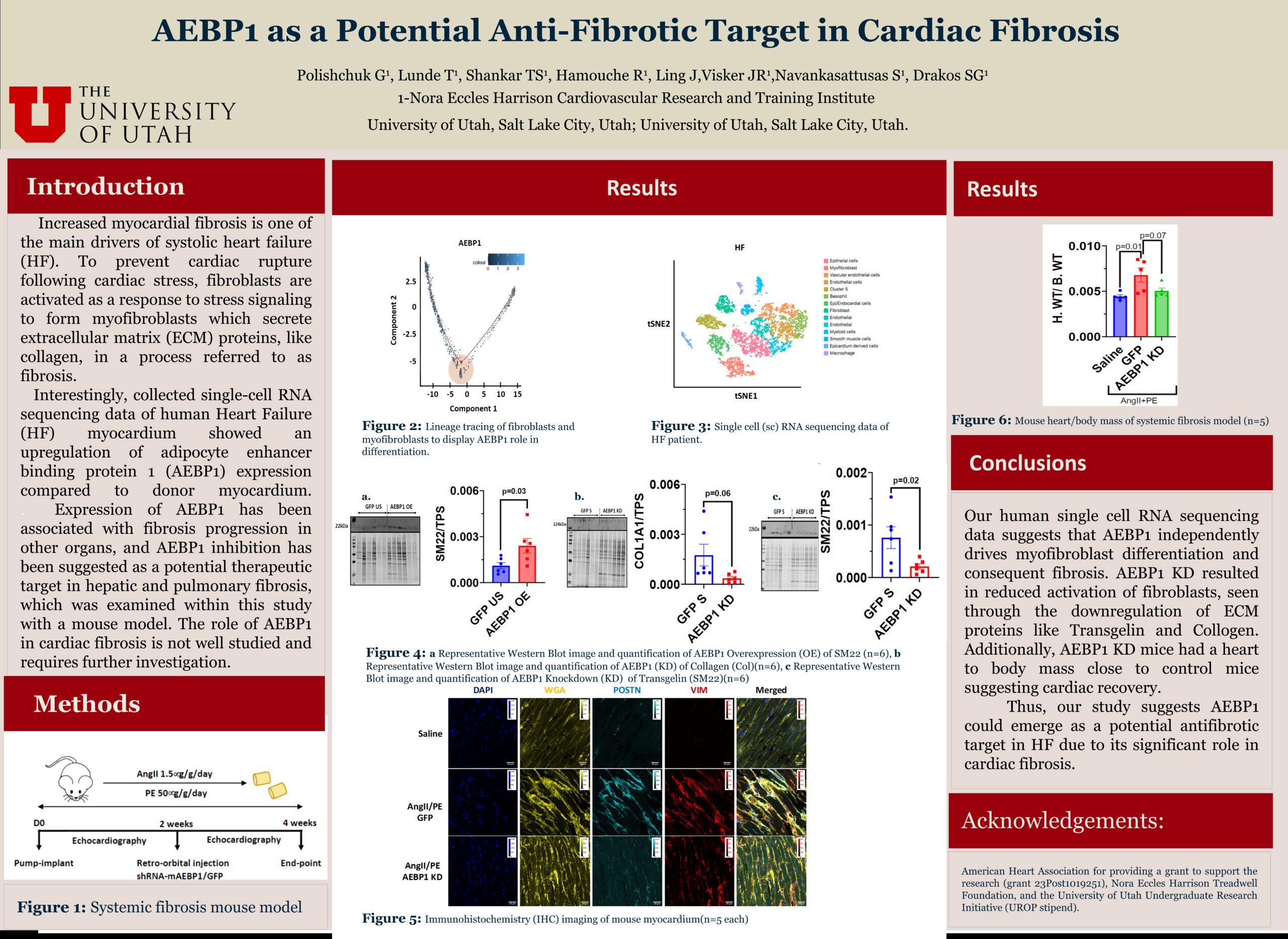Presenter Name: George Polishchuk
Description
Cardiovascular diseases are the leading cause of death globally. Increased myocardial fibrosis is one of the main drivers of systolic heart failure (HF), which limits the heart's ability to pump blood adequately to the rest of the organs. To prevent cardiac rupture following cardiac stress, fibroblasts are activated as a response to stress signaling to form myofibroblasts which secrete extracellular matrix (ECM) proteins, like collagen, in a process referred to as fibrosis.
Interestingly, single-cell RNA sequencing data of human HF myocardium showed an upregulation of adipocyte enhancer binding protein 1 (AEBP1) expression compared to donor myocardium. Expression of AEBP1 has been associated with fibrosis progression in other organs, and AEBP1 inhibition has been suggested as a potential therapeutic target in hepatic and pulmonary fibrosis. The role of AEBP1 in cardiac fibrosis is not studied and needs further investigation.
With AEBP1 overexpression (OE), smooth muscle actin (SMA, marker of myofibroblast, n=6, p=0.06), transgelin (SM22, early marker of smooth-muscle cell differentiation, n=6, p=0.03), and collagen (n=6, p=0.002) were also observed. Likewise, AEBP1-KD resulted in significant downregulation of SM22 (n=6, p=0.02) and collagen1 (n=6, p=0.06) indicating an AEBP1-dependent pathway in cardiac fibrosis. Additionally, mice which had multi-organ fibrosis induced through angiotensin and phenylephrine 4-week treatment. 2 weeks following induction, a group of mice was treated with adeno-associated virus 9 (AAV9) containing shRNA targeting AEBP1 to induce KD while the remaining received control AAV9 (n=5 each). A significant reduction in SM22 (n=5, p=0.06) displayed a significant reduction of fibrosis within KD mice with additional conformational data from immunohistochemistry. Thus, our study suggests AEBP1 could emerge as a potential antifibrotic target in HF due to its significant role in cardiac fibrosis.
Interestingly, single-cell RNA sequencing data of human HF myocardium showed an upregulation of adipocyte enhancer binding protein 1 (AEBP1) expression compared to donor myocardium. Expression of AEBP1 has been associated with fibrosis progression in other organs, and AEBP1 inhibition has been suggested as a potential therapeutic target in hepatic and pulmonary fibrosis. The role of AEBP1 in cardiac fibrosis is not studied and needs further investigation.
With AEBP1 overexpression (OE), smooth muscle actin (SMA, marker of myofibroblast, n=6, p=0.06), transgelin (SM22, early marker of smooth-muscle cell differentiation, n=6, p=0.03), and collagen (n=6, p=0.002) were also observed. Likewise, AEBP1-KD resulted in significant downregulation of SM22 (n=6, p=0.02) and collagen1 (n=6, p=0.06) indicating an AEBP1-dependent pathway in cardiac fibrosis. Additionally, mice which had multi-organ fibrosis induced through angiotensin and phenylephrine 4-week treatment. 2 weeks following induction, a group of mice was treated with adeno-associated virus 9 (AAV9) containing shRNA targeting AEBP1 to induce KD while the remaining received control AAV9 (n=5 each). A significant reduction in SM22 (n=5, p=0.06) displayed a significant reduction of fibrosis within KD mice with additional conformational data from immunohistochemistry. Thus, our study suggests AEBP1 could emerge as a potential antifibrotic target in HF due to its significant role in cardiac fibrosis.
University / Institution: University of Utah
Type: Poster
Format: In Person
Presentation #B52
SESSION B (10:45AM-12:15PM)
Area of Research: Science & Technology
Email: u1299806@umail.utah.edu
Faculty Mentor: Stavros Drakos

